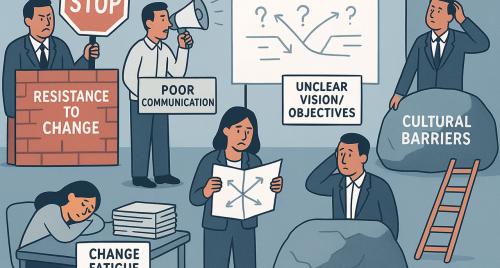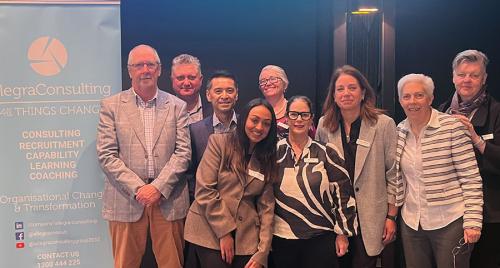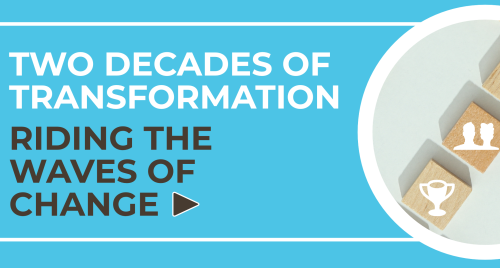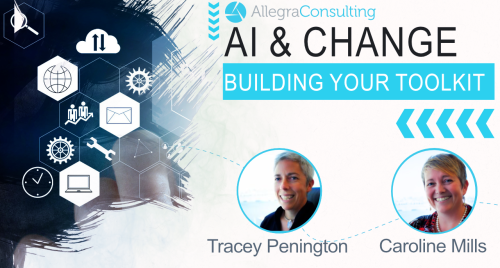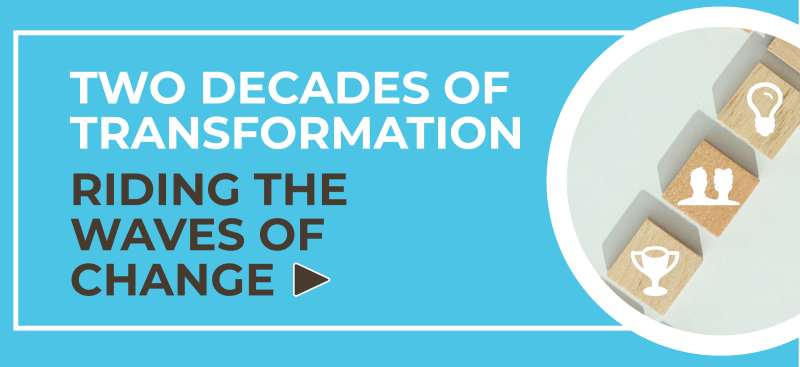
This month marks a major milestone - 20 years of Allegra Consulting navigating the ever-evolving world of change management and transformation. It's been a whirlwind of shifts, not only in the global landscape but in the very way we approach change within organisations. From the tech boom to social media revolutions, we've seen it all. So, grab your favourite cuppa and take a stroll down memory lane to see how our approaches to change have transformed over the years!
The Early Days of Change Management
Remember the early 2000s? Everyone was getting over the Y2K scare and in the world of organisational development, we were still like pioneers setting out in a vast, uncharted territory. Back then, change management was largely about the psychology of change. We were heavily leaning on theories and models that felt like using a compass to navigate through fog. You knew you were going somewhere, but you couldn't see far ahead.
We relied on tools like the Bridges Transition Model, Kubler Ross and her grief process and Kotter’s 8-Step Process, which was the GPS of change management at the time. Change Managers were scattered across the larger organisation, sometimes in change practices, but many organisations didn’t see the need for change professionals. Meanwhile, the world was reeling from the dot-com bubble burst, setting the stage for a new era of technology-driven change.
Integration with Project Management
As the years rolled on, we started seeing the tapestry of change management woven into the broader fabric of project management. This was like adding a turbo engine to a classic car. Suddenly, we weren’t just talking about feelings and resistance; we were mapping out meticulous plans with milestones and deadlines. Certifications became the new norm, and methodologies like PMI and PRINCE2 started to dictate the rhythm of our work. Sure, it was challenging, but how satisfying it was to see projects starting to achieve more sustainable outcomes!
We got lost at times in this middle piece, sometimes focusing too much on the documentation and “widgets” and less on helping behaviour move from a current place to a future place. I have always said you can fill out all the documents in the world and yet not do any real change management. The reverse is true, not filling out a heap of documents, yet in fact, being successful at working with teams and leaders at shifting behaviour. The mid-2000s also brought us monumental events like the global financial crisis, which taught us the hard lessons about resilience and adaptability.
Today’s Holistic Approach
Fast forward to today, and it's like we're conducting an orchestra with instruments from both the project management and the psychological realms. We find ourselves more aligned with an organisational change approach, thinking about culture and the impacts of change in a more holistic way and also working on change where the future might not be locked in and the path to deliver that change is not as linear. The music we create now is richer, with every note and pause carefully crafted through digital platforms and, more recently, AI-driven analytics. This approach doesn't just manage change; it anticipates and adapts to it, making the process smoother and more intuitive. Incorporating methods and tools from Agile, Lean, Six Sigma, Human-Centred Design and Design Thinking has grown our toolbox, and good practitioners pull the ones out needed for the contextual situation they find themselves in. With the world spinning faster than ever thanks to social media and real-time global connectivity, being flexible and adaptive has become essential in keeping pace with rapid change.
Democratisation of Change Management
One of the most exciting developments, in my opinion, has been the democratisation of change management. Back in the day, it seemed like only the big organisations had a seat at the table, with specialised change managers and budgets that saw the need. Now, we're seeing change leadership embedded at every level of organisations, big and small. It’s like cooking a gourmet meal at home, everyone gets involved, each adding a pinch of this and a dash of that, making the end result not just delicious but more satisfying because everyone had a hand in creating it. This marks a shift in direction, where change practitioners are seen more as facilitators and enablers, helping to build change capability within organisations, leaders and employees, rather than being solely responsible for delivering the change themselves.
Looking Ahead
What’s next for us? I think for now, it’s a continued evolution, moving away from ‘owning’ the change ourselves and toward a role of facilitating change through others and across the organisation. When I talk about this with practitioners, I can literally see the weight lifting off their shoulders. We are also seeing the impacts of change on the health of organisations, the growth of awareness around psychological safety and how change can impact this, so an even closer relationship with our HR/People & Culture colleagues, ensuring the organisations we work in have strong approaches to wellbeing, will be important. The future is as thrilling as it is unknown, the pace of change is not slowing, but one thing’s for sure, adaptability and continuous learning will be our guiding stars. As we keep riding this wave, let’s not just react to change but dance with it, leading with curiosity and resilience.


